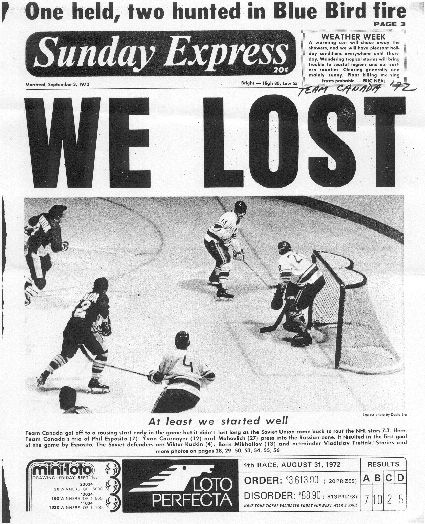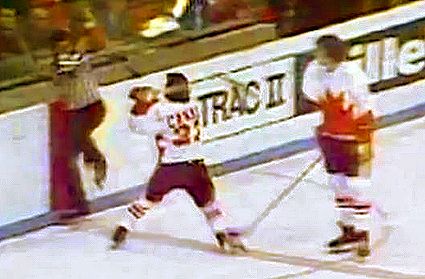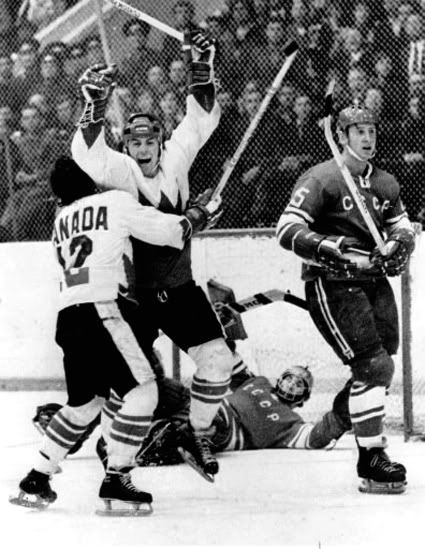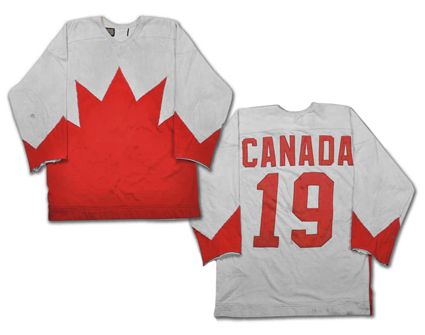"Here's a shot. Henderson makes a wild stab for it and falls. Here's another shot. Right in front. They score! Henderson scores for Canada!"
The most famous goal in Canadian hockey history occurred on this date in 1972, as
Paul Henderson scored with 34 seconds remaining in Game 8 of the 1972 Summit Series between Canada and the Soviet Union.
The Summit Series was a groundbreaking event in not only hockey history, but international politics as well. The series would be the first time that the Canadians were able to take on the Soviets with a full squad of professional players head to head against the best that the Soviets had to offer. Most in Canada fully expected an easy time of it for Team Canada, with some even predicting an eight-game sweep.
That was not to be, however, as all of Canada was stunned when the Soviets came back from an early 2-0 deficit in Game 1 to win 7-3 in Montreal.

The stunned reaction in Canada to their Game 1 defeat
Canada would win Game 2 in Toronto by a score of 2-1 with the Soviets coming from behind by two goals in Winnipeg to earn a tie in Game 3.
Game 4 would see the Soviets up 4-1 after two periods, with the final score being 5-3, earning Team Canada a shower of boos from the Canadian crowd, earning them a tounge-lashing from a frustrated Phil Esposito as the series was about to head off to Moscow for the final four games.
Things did not start off any better for the Canadians in Moscow either, as Team Canada led 4-1 only to have the Soviets come back to win the game 5-4, putting them ahead three games to one, along with a tie and three home games remaining.
Game 6 went better for Team Canada, despite having 31 penalty minutes called against them versus only 4 assessed to the Soviets, Canada would win 3-2 in a game that would feature a pivotal moment in the series, as Bobby Clarke would fracture the Soviet's best forward Valeri Kharlamov's ankle with a deliberate slash.
Canada would even the series at three games each by winning Game 7 by a score of 4-3, with Henderson scoring the winning goal with a shade over two minutes remaining, setting up a decisive Game 8.
While the series was supposed to be a "friendly" series of exhibition games with no overall winner, the Game 3 tie in Winnipeg left an odd amount of games to divide between the two sides, and when hen the Soviets proclaimed that even if Game 8 ended in a tie, they would be the winners on the basis of scoring one more goal than the Canadians during the series.
In an effort to ensure the best possible chance for a Soviet victory, they orchestrated a change in officials the night before the decisive game, choosing to replace the previously selected Swede and Czech referees with the same East German pair
Josef Kompalla and
Franz Baader
that were responsible for the great discrepancy of 27 penalty minutes in Game 6, so much so that the Canadians nicknamed the pair "Baader and Worse".
Canada threatened to leave Moscow without even playing Game 8 if that were the case and a compromise was reached where the the Soviets hand picked their favorite East German
, while the Canadians got to choose the Czech ref Rudi Bata, who Canadian organizer Alan Eagleson figured didn't like the Soviets any more than he did!
Sure enough, just three minutes into the game Canada was two men short and gave up a power play goal. At 4:10, J. P. Parise was given yet another minor and his threatening reaction earned him a ten-minute misconduct. Now enraged, Parise's threatening outburst got him thrown out of the game as a game misconduct was added on.
Phil Esposito would score once the hockey resumed to tie the game at 6:45 and then the teams would trade goals by Vladimir Lutchenko and Brad Park to finish out the first period tied at 2-2.
The Soviets would use a little home ice advantage to score in the first minute of the second, as the puck was fired over the goal, only to take a large rebound off the mesh netting that topped the boards rather than the plexiglass of North American arenas. Vladimir Shadrin would put the puck behind Ken Dryden after it landed back into the area in front of the Canadian goal.
Bill White would score for Canada halfway through the period, only to have the Soviets score just over a minute later to regain the lead again and then once more on the power play at 16:44 to take a 5-3 lead into the third period.
Phil Esposito would ignite the Canadians with a goal at 2:27 of the third to pull Canada back within one. Esposito again charged the net and Yvan Cournoyer was able to put the rebound past Vladislav Tretiak at 12:56, only to have the Soviet goal judge fail to turn on the goal light, but the goal did count to tie the game. Again, a tie would allow the Soviets to claim a series victory, so the Canadians were still desperate to score another.
With the game now winding down in the last minute of play, Cournoyer intercepted a Soviet clearing attempt and passed to Henderson. The pass was behind him and he was tripped on the play as well, which sent him crashing into the end boards to the side of the Soviet goal.
At that point, Esposito, who was following the play, put the puck softly in front of the goal where Henderson, now back on his skates and, returning to play from behind the net, was able to jump on the loose puck and swat it towards Tretiak, who blocked with his leg. The puck bounced off his pads, allowing Henderson a second shot at glory, which he put over the sprawled Soviet goaltender to give Canada the series victory with only 34 seconds remaining in the contest.
Cournoyer hugs a jubilant Henderson seconds after he
cemented his place in hockey immortality
The success of the 1972 Summit Series led to an attempt at a repeat in 1974, only this time with a team made up of players from the World Hockey Association, which was one sided in favor of the Soviets and failed to capture the public's imagination despite the inclusion of both
Gordie Howe and
Bobby Hull, who were both absent in 1972.
The concept of the Summit Series eventually evolved into the Canada Cup tournament, which featured an expanded field of six teams, which in turn led to the current World Cup of Hockey.
The 1972 Summit Series also influenced many aspects of how the game was approached and played in North America, with off-season training now becoming important, as well as various strategy differences in puck possession and player positioning.
Today's featured jersey is a 1972 Team Canada Paul Henderson jersey as worn during the four games played in Moscow.
This jersey came up for public sale for the first time ever at auction in June of 2010 on ClassicAuctions.net, a leading online auction website based in Quebec, Canada. Fears immediately were voiced from many corners of the hockey world that this historic jersey would fall into the wrong hands - such as those of a trading card company like Be A Player or Upper Deck, who have made a business out of cutting up historical sports artifacts into hundreds of small pieces in order to create collectible trading cards.
Notable previous losses of significant items include the only set of goalie pads worn by Georges Vezina and a 1925 New York Yankees Babe Ruth jersey among the dozens of items that have been desecrated for the sake of short term profits by card companies.
The concern and publicity over the possible threat to "the most significant artifact in the history of the game of hockey" eventually saw the jersey sell for a record shattering $1,275,707, far outstripping the reported $250,000 paid for a Wayne Gretzky game worn jersey and the $191,000 for a Bobby Orr rookie jersey.
The winning bidder, Canadian real estate developer Mitchell Goldhar, not only preserved the jersey from possible destruction, but returned it to Canada from where it had been located in the United States, but took the iconic Canadian sweater on a tour of the country in an effort to share it with the citizens of the nation where everyone remembers where they were when Henderson score his dramatic goal. One of the highlights of the return of the jersey to Canada was having Henderson don the jersey once again.
There is much more than can be written and examined about this series, it's significance and it's impact, and in fact many have done just so, as there are a number of books available on the subject as well as DVD sets of the games.
Finally, here is Henderson himself, telling the story from his unique point of view of the series and his famous goal.















No comments:
Post a Comment
We welcome and encourage genuine comments and corrections from our readers. Please no spam. It will not be approved and never seen.